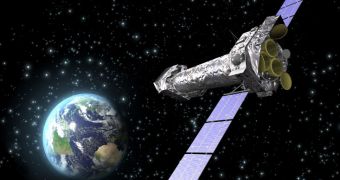Astronomers with the European Space Agency say that recent data provided by the ESA XMM-Newton space telescope indicate the existence of an unusual cosmic phenomenon. The readings show that a neutron star tried to gobble up a large chunk of matter, but failed to do so
Usually, when viewed in the X-ray wavelengths at which Newton operates, the faint star in the binary system IGR J18410-0535 appears very dim. But during a routine observations mission, the telescope saw the object flare up to about 10,000 times its usual brightness.
That was extremely odd for astronomers, who had no idea as to what might have caused such a violent event at first. After some studies of the star were conducted, the conclusion became apparent – the star had tried to accrete a large volume of matter at once.
The binary system ESA observed is made up of a neutron star and a blue supergiant companion. The latter apparently emitted a vast amount of mass in its surroundings, which eventually made its way to the surface of the neutron star.
Packed together in a sphere about 10 kilometer across, the star is extremely dense and heavy, and therefore exerts a massive gravitational pull on its surroundings. Regardless, it was unable to consume all of the matter that the blue supergiant released its way.
“This was a huge bullet of gas that the star shot out, and it hit the neutron star allowing us to see it,” explains research leader Enrico Bozzo, who holds an appointment at the University of Geneva ISDC Data Center for Astrophysics.
The X-ray emissions that Newton saw were produced as the intense gravitational pull of the neutron star heated the large gas cloud to millions of degrees within short time frames. The hydrogen and helium in the gas got to hot that they releases X-ray radiation.
According to experts, the massive X-ray burst lasted for only 4 hours, and was included from beginning to end in the telescope's 12.5-hour observation session. “I don’t know if there is any way to measure luck, but we were extremely lucky,” Dr. Bozzo says.
“This remarkable result highlights XMM-Newton's unique capabilities. Its observations indicate that these flares can be linked to the neutron star attempting to ingest a giant clump of matter,” XMM-Newton project scientist Norbert Schartel explains.
Data the telescope collected will now be analyzed throughly. Based on them, experts hope to obtain new insights into the nature of the blue supergiant and of the neutron star that accompanies it.
A high-definition .gif file showing a model of the X-ray flare is available here.

 14 DAY TRIAL //
14 DAY TRIAL //